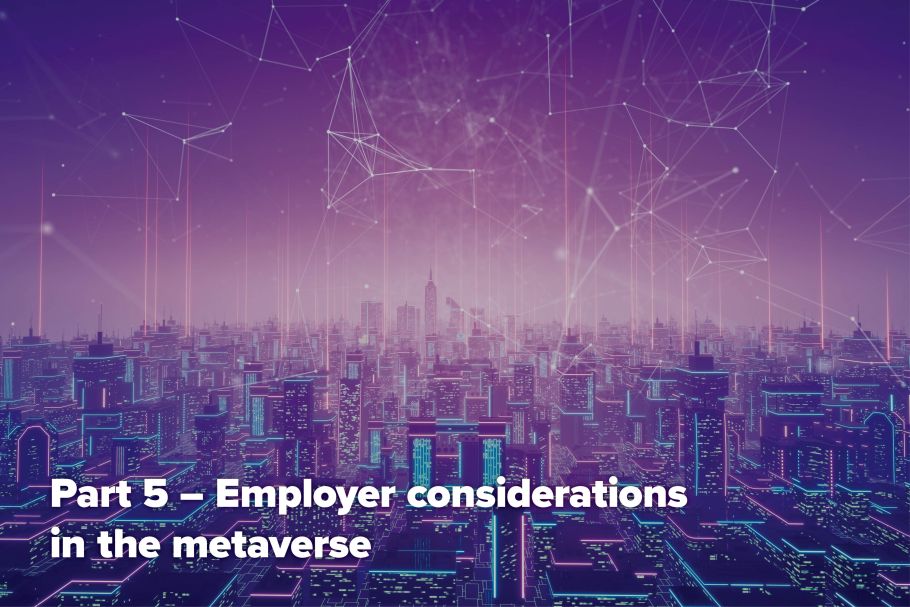
Contributors: Joanna Boag-Thomson, Carly Duckett
Date published: 9 February 2023
The Metaverse series – Part 4 – Protection of intellectual property rights
As discussed in our previous articles (available here, here and here) businesses are increasingly using the metaverse to promote their brand and increase consumer engagement. Whilst harnessing the metaverse technology provides a real opportunity for brand owners, it is also important for organisations to consider protecting the brand’s intellectual property (IP). This is previously unchartered territory and, as with the regulatory approach to advertising, there is a lack of clear legal guidelines or precedent. A fundamental issue with protection of IP rights in the borderless, virtual world of the metaverse is that IP rights are subject to the principle of territoriality. This means that they only have effect in the jurisdictions that grant them.
As more IP disputes are raised, it is possible that a body of precedent will emerge to provide clearer guidance on the protection of IP in the metaverse, or an international approach could be adopted, similar to the inception of the World Intellectual Property Office’s Domain Name Dispute Resolution service which can resolve cross-border domain name disputes, without the need for parties to go to court. In the meantime, this article sets out the key points that brand owners should be considering and discusses some practical steps that can be taken at this stage to protect their IP.
Trade marks
Currently, the primary method of protection of virtual goods and NFTs is using trade marks. In the real world, to benefit from trade mark protection, goods or services need to fall into specific classifications. It is not clear whether this existing protection will be sufficient for the metaverse. These classifications don’t transpose seamlessly to the virtual world of the metaverse. Tangible goods potentially fall into a different classification from their virtual equivalent. For example, a t-shirt in reality and the electronic image of that t-shirt in the metaverse would fall under different classifications. As such, we would encourage brand owners to submit trade mark applications for the digital equivalent of physical goods. The EU IPO has indicated that it won’t be sufficient for a trade mark applicant to file for the term “virtual goods”, and they will need to specify the content to which the virtual goods relate, for example “downloadable virtual goods, namely virtual clothing.” Prominent brands such as Nike, Walmart, McDonalds and Gucci have applied for trade marks for virtual goods and services in classes 9, 35 and 41.
It is not clear whether trade mark protection will continue as the dominant approach for the protection of intellectual property. Virtual goods and NFTs can be images or video content, which makes them challenging to protect using trade marks. As the metaverse develops, the focus could move from trade marks to copyright protection which is traditionally used to protect images.
Copyright
While some commentators suggest that copyright may be an appropriate means by which to protect IP in the metaverse, there are undeniably a number of gaps that could be exploited by third parties. Enforcement of copyright in the metaverse should be a key concern for authors and creators because of the ease with which copyright can be infringed online, and the difficulty they might encounter in trying to identify who to take enforcement action against. This is particularly prominent in relation to NFTs: anyone can convert a work that is protected by copyright into an NFT which could lead to a clash between the rights of the original author of the work and those of the NFT creator in the metaverse.
Patent
Anyone creating patentable technologies in the metaverse should also consider whether to protect those products. Patents in the metaverse must meet the same basic requirements of patentability as physical products, namely novelty, an inventive step and being capable of industrial application. As with the physical world, one of the issues with patent protection is the question of who or what should be the owner of the patent. Those considering patent protection will need to think carefully about how to apply for patent protection. For example, if an avatar invents a product in the metaverse, will they be able to apply directly to the relevant offices in the real world for patent protection, or will the real person who is represented by the avatar need to do so? And what if the creator wants to build an equivalent product in reality?
What can brand owners do now?
Many brand owners have already experienced violations of their IP rights. Nike has sued a company called StockX, citing a number of IP related infringements including trademark infringement and dilution. StockX is an online reseller of various products, including Nike shoes (though it is not officially partnered with Nike).
In 2022, StockX launched a collection of NFTs through ‘Vault NFT’. The Vault NFTs are linked to the physical products that StockX sells (including Nike shoes). This should allow resellers to trade physical products without having to have them shipped and authenticated first, because the physical product remains in StockX’s vaults while the NFTs are traded. When the purchaser wants to receive the physical product, they can redeem the NFT and StockX will send the purchaser the physical product.
As StockX are resellers of Nike shoes, of which StockX has created various NFTs, Nike alleges that StockX is minting, marketing and selling NFTs that include Nike’s trademarked logo without its authorisation. Nike claims that StockX’s actions are capitalising on Nike’s goodwill and misleading customers with inflated prices. Nike also claims that this is impeding its ability to successfully move into the digital marketplace.
This is one of many cases that highlight the importance of businesses being proactive in protecting their IP as far as they can within the current legal framework.
Some key steps that businesses should consider are as follows:
- Undertake regular brand audits to assess the number of IP assets they have, the level of protection afforded to those assets and whether that protection is appropriate and sufficient;
- Monitor the market for any infringement and/or counterfeit goods;
- Be prepared to take appropriate enforcement action; and
- Embrace the metaverse. As discussed, this will both aid in the promotion of the brand and allow the brand owner to have better access to the community in which the alleged infringements are occurring.
Given the increasing popularity of the metaverse, legislators and regulators will appreciate the critical importance of having an intellectual property regime which adequately protects the rights of brand owners throughout the world (both physically and virtually). Exactly how this will be done remains to be seen.
The Metaverse series
- Part 1 – Introduction to the metaverse
- Part 2 – Non-fungible tokens (NFTs)
- Part 3 – Brand considerations in the metaverse
- Part 4 – Protection of intellectual property rights
- Part 5 – Employer considerations in the metaverse
If you would like further information about the topics covered in this series, please contact, Joanna Boag-Thomson or Carly Duckett.
Contributors:
Joanna Boag-Thomson
Partner
Carly Duckett
Associate
To find out more contact us here
Expertise: Commercial Contracts, Corporate and Commercial, Dispute Resolution, Intellectual Property, Intellectual Property Disputes
Sectors: Pharma, Biotech, Medtech, and Digital Health, Technology and Life Sciences

















